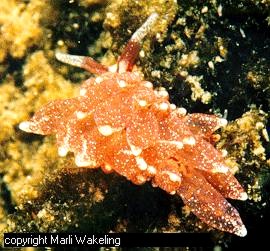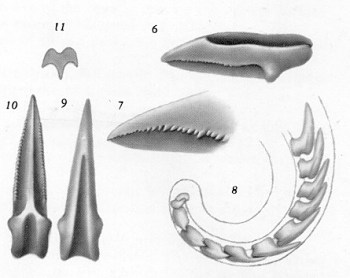
Hermaea oliviae
(MacFarland, 1966)
Order: SACOGLOSSA
Superfamily: LIMAPONTIOIDEA
Family: Hermaeidae
DISTRIBUTION
Southern California to British Columbia, Canada.
PHOTO
Seymour Inlet, British Columbia, Canada, 20 feet, 1998. Photo: Marli Wakeling.
See message below.
Note: Genus changed from Aplysiopsis to Hermaea - 7 November 2001. see Kathe Jensen's message.
Reference:
• MacFarland, F.M. (1966) Studies of opisthobranchiate molusks of the Pacific coast of North America. Memoirs of the California Academy of Sciences, 6: 1-546.
Rudman, W.B., 2000 (June 11) Hermaea oliviae (MacFarland, 1966). [In] Sea Slug Forum. Australian Museum, Sydney. Available from http://www.seaslugforum.net/find/aplyoliv
Related messages
Re: Aplysiopsis oliviae from British Columbia
November 8, 2001
From: Kathe R. Jensen
Dear Bill,
This is actually a reply to your comments your comments on the question from a California teacher, who asked about hermaphroditism. You mentioned that the Californian species of Aplysiopsis is A. oliviae. I don't think this is correct, so I checked the A. oliviae page, and I still believe that this species is Hermaea - especially after seeing your reproduction of MacFarland's figure of the teeth. They are almost identical to the teeth of Hermaea evelinemarcusae, which I described from Rottnest Island.
The Californian species of Aplysiopsis, I believe is now called Aplysiopsis enteromorphae (Cockerell & Eliot, 1905). Previously this species was known as Aplysiopsis ( =Hermaeina) smithi (Marcus,1961). I am sure Cynthia Trowbridge knows the full story about the synonymisation of the 2 species.
Greetings,
Kathe
jensen@ait.ac.th
Jensen, K.R., 2001 (Nov 8) Re: Aplysiopsis oliviae from British Columbia. [Message in] Sea Slug Forum. Australian Museum, Sydney. Available from http://www.seaslugforum.net/find/5616Dear Kathe,
Life gets complicated. I left the species as Aplysiopsis oliviae until I heard from you. I posted MacFarland's illustration with your last message so you could confirm it was indeed a Hermaea. It's a bit complicated changing names on the Forum so I only do it when I am sure everyone - or at least one other person - will agree.
Cheers,
Bill Rudman
Re: Aplysiopsis oliviae from British Columbia
June 28, 2000
From: Cynthia Trowbridge
Dear Marli, Kathe, and Bill,
To follow up on comments that the species probably eats red algae, I would like to mention that Sandra Millen (1980) reported the slug ate the red algae Griffithsia pacifica and Polysiphonia hendryi. My own experience is that Griffithsia is not very common; in fact, the only place I recall ever have seen Griffithsia on the west coast is on the floating docks at Friday Harbor Labs in Friday Harbor, Washington (USA). In my 17 years of research on the Oregon coast, I personally have never seen Griffithsia here (yes, I have looked!). Polysiphonia spp. are really difficult for me (and others) to identify. Thus, the scarcity of the Aplysiopsis oliviae reports may be due to scarcity of the algal hosts and/or the biology of the ascoglossan species per se. Anyway, I note the past papers on this species are as follows:
• MacFarland, FM (1966) Studies of opisthobranchiate mollusks of the Pacific coast of North America. Mem. Calif. Acad. Sci. 6: 1-546.
• Lee, RS & Brophy, P (1969) Additional bathymetric and locality data for some opisthobranchs and an octopus from Santa Barbara County, California. The Veliger, 12: 220-221.
• Gosliner, TM & Williams, GC (1970) The opisthobranch mollusks of Marin County, California (Gastropoda). The Veliger, 13: 175-180.
• Williams, GC & Gosliner, TM (1973) Range extensions for four sacoglossan opisthobranchs from the coasts of California and the Gulf of Mexico (Mollusca: Gastropoda). The Veliger, 16: 112-116.
• Millen, SV (1980) Range extensions, new distribution sites, and notes on the biology of sacoglossan opisthobranchs (Mollusca: Gastropoda) in British Columbia. Can. J. Zool., 58: 1207-1209.
All the best,
Cynthia
Hatfield Marine Science Center
Oregon State University, USA
trowbric@ucs.orst.edu
Trowbridge, C., 2000 (Jun 28) Re: Aplysiopsis oliviae from British Columbia. [Message in] Sea Slug Forum. Australian Museum, Sydney. Available from http://www.seaslugforum.net/find/2627Thanks Cynthia,
Following Kathe Jensen's comments, I wouldn't mind some advice on whether I should be calling this animal Hermaea rather than Aplysiopsis.
Note: Genus changed from Aplysiopsis to Hermaea - 7 November 2001. see Kathe Jensen's message.
Best wishes,
Bill Rudman.
Re: Aplysiopsis oliviae from British Columbia
June 16, 2000
From: Kathe R. Jensen
Dear Marli (& Bill),
My copy of Behrens' book (2nd edition, p. 42) does have a photo of this species, and also a comment that the radula indicates that this species is a Hermaea. As I have said in many previous messages, I am away from the well-stocked mollusc library in Copenhagen, so I have not been able to consult the original description. But the colouration in this latest photo of the species clearly suggests a red algal diet, which is also indicative of the genus Hermaea. Also the fact that it was found on a piece of kelp - presumably with epiphytes - is an indication of this.
To be sure you would have to look at radular teeth. Aplysiopsis has very distinctive teeth ("sabot-shaped" with denticles on cutting edges). Hermaea have more "typical" teeth (blade-shaped, with or without minute lateral denticles).
Regards,
Kathe
jensen@ait.ac.th
Jensen, K.R., 2000 (Jun 16) Re: Aplysiopsis oliviae from British Columbia. [Message in] Sea Slug Forum. Australian Museum, Sydney. Available from http://www.seaslugforum.net/find/2582
Dear Kathe,
Thanks again for your comments. I should have used Dave Behren's 1991 edition. My only excuse is that, as you may have noticed, I have been trying to clear a large backlog of messages, and I couldn't find it. I have now found it so I will also note that both Cuthona punicea and Catriona columbiana are in the 1991 edition.
I have scanned MacFarland's illustrations of the teeth of what he calls Hermaeina oliviae (Pl 10, figs 6-11). From your comments I guess the shape suggests that this is a species of Hermaea.
Best wishes,
Bill Rudman.
Aplysiopsis oliviae from British Columbia
June 14, 2000
From: Marli Wakeling

Hi Bill,
Here is Aplysiopsis oliviae. It is not a nudibranch, but a sacoglossid opisthobranch, from the Hermaeidae family. This is a very rare animal known formerly from Monterey Bay, California to the southern Gulf Islands, British Columbia. I found it in 1998, 450 miles further north, at Seymour Inlet on a muck dive at 20 feet on a piece of kelp. Whether it could be attributed to El nino or just that few people look for creatures this tiny is the question, I suppose!
The Forum is running much faster, by the way.
Regards,
Marli Wakeling
scubamarli@excite.com
Wakeling, M., 2000 (Jun 14) Aplysiopsis oliviae from British Columbia. [Message in] Sea Slug Forum. Australian Museum, Sydney. Available from http://www.seaslugforum.net/find/2521Thanks Marli,
This is one of the few sacoglossans which aren't predominantly green! I see that Dave Behrens could not find a photo for Pacific Coast Nudibranchs [1980 - Edition 1] so this may be one of the few published photos of the animal.
I'm glad you are finding the Forum running a lot faster. I hope everyone can notice a significant difference. Apart from a shutdown, beyond our control on Saturday, everything is running well and hopefully much faster.
Best wishes,
Bill Rudman.
